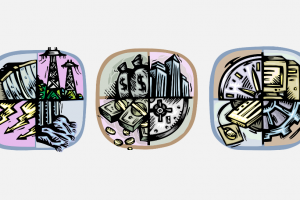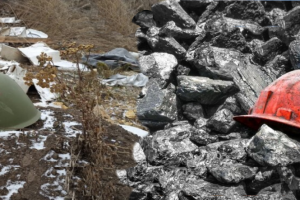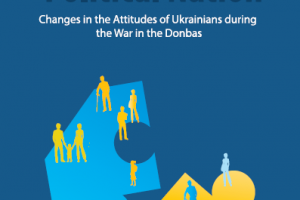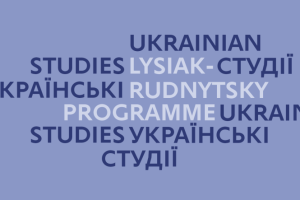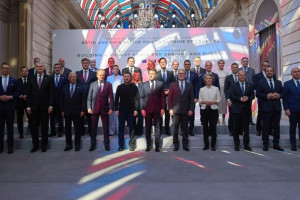Civil Society and Mass Mobilization
The TCUP Conference continued on Tuesday, February 2, 2021, with a lively discussion of the role of civil society and mass mobilizations in Ukrainian democracy.
Panelists reiterated throughout that there are many terms in this area that are used interchangeably but that need to be clarified. Most importantly, “mass mobilizations” or “popular uprisings” are moments in which many ordinary people come together to make demands on their (elected) representatives and the people who make up state power. “Civil society” typically includes non-governmental sectors of society, such as volunteer groups and non-governmental organizations. Civil society is often imagined as an existing entity through which we can measure democracy, but in reality, it is a “key symbolic operator,” or an idea that is circulated as though it were meaningful without having any concrete substance. When we want to analyze and measure these parts of society, we must be careful with our terms if we wish to understand how Ukraine’s experience is unique.
Ukraine’s Mass Mobilizations
Moderator Emily Channell-Justice asked if Ukraine’s mass mobilizations are unique in the world. Olga Onuch argued, based on comparative research in the post-Soviet region and in Latin America, that Ukraine’s mass mobilizations are not unique, but having two of them so close to one another (2004 and 2014) is uncommon. Lucan Way agreed, pointing out that both of those mobilizations targeted the same political figure, Viktor Yanukovych. But in the global context, the Ukrainian protests were not different from, for instance, mass mobilizations in Tahrir Square (Egypt), Gezi Square (Turkey), or recent protests in Cameroon.
Olexiy Haran referred to the Orange Revolution of 2004 and the Euromaidan protests of 2013-2014 as the first and second Maidans; Way also referenced 1990’s Revolution on Granite as a major mobilization toward democracy in Ukraine. Haran argued that the many protests that have taken place in the years since Euromaidan, sometimes referred as “Maidans,” are not really mass mobilization events because they are about particular demands, rather than shared values and democratic principles. In general, these major protest movements have prevented the consolidation of power in authoritarian regimes, making Ukraine distinct from its post-Soviet neighbors. Haran argued that Euromaidan showed many Russians that democracy is possible, and that mobilization helped encourage the development of civic nationalism in Ukraine, rather than a Ukrainian identity based on linguistic and ethnic identification.
Several panelists pointed out the horizontal nature of the 2013-2014 protests. While Opposition elites attempted to lead the protests, the main driver of the mobilizations was ordinary citizens. Way argued that civil society and political parties were not behind the protest movements of 2004 or 2013-2014, even though the latter protests were extremely well organized. Galyna Petrenko noted the importance of social media as a major factor that differentiated the Orange Revolution and Euromaidan. In 2004, social media played little to no role, but by 2013, Facebook, Twitter, and VKontakte were major vectors for information sharing and organizing. Access to social media certainly helped encourage the horizontal form that those protests took.
Channell-Justice asked whether regular mass protests are good for Ukrainian democracy. Onuch responded that there are two ways to look at the problem: Mass protest is a feature of Ukrainian democracy, and it is a way for citizens to hold politicians to account. However, if mass protest is the only way to hold politicians to account, then it becomes a sign of democratic weakness. The routinization of using protest as a way to challenge the government means that smaller and smaller triggers can start to bring people to the street; this leads to instability rather than a strong democracy. Way agreed later in the panel, stating that recurring protests are not a good way to get the government to follow the rules established in a democracy; however, a strong civil society can be that stable force that holds the government accountable.
Post-Maidan Developments: Volunteerism, Decentralization, and the Far Right
The growth of the volunteer sector after the Euromaidan protests has shaped the analysis of civil society in Ukraine. Petrenko’s survey data from August 2020 shows an increased trust in voluntary and civic organizations; however, only a small percentage of Ukrainian actually participate in these organizations, aside from making donations. Haran argued that the role of civil society has increased in Ukraine, and civil society organizations are no longer perceived as “foreign agents,” even though many still receive funding from international organizations. The question now is, why does President Zelensky seem to view civil society with suspicion? Onuch continued this line of thinking, noting what she sees as “partisan” civil society, which holds certain types of politicians to account more than others. For instance, Zelensky is always criticized by a certain segment of civil society, despite making major accomplishments; Poroshenko experienced the same criticisms from a different segment of civil society. And, as Petrenko pointed out, while new reforms have made it easier to register non-governmental organizations, and there has been an increased focus on their financial sustainability, there has also been an increase in legislative moves that are hostile to civil society and in attacks on journalists and civic activists.
The panelists agreed that recent decentralization reforms have had a positive impact on democratization in Ukraine. Onuch’s data shows that people have become more involved in local politics, and they have a more positive view of democracy at both local and national levels (even as negative sentiments toward the state itself have grown). At the same time, Haran argued, with the greater distribution of resources at the local level, local elites have the chance to try to control those resources, continuing the corrupt practices present at the national level. Another major political factor that developed out of Euromaidan is right-wing groups. Some of these include populist groups, as Haran pointed out, but others are radical right-wing forces that attempt—and have thus far failed—to gain political representation. Way argued that the far right is still marginal in electoral politics and is not nearly as dominant as Russian propaganda asserts, but it is still important to recognize them. In fact, their existence and the conflict around them shows that Ukraine is becoming a “normal” country, he said.
Supporting Ukraine’s Democratic Future at Home and Abroad
The Ukrainian diaspora and Ukrainians abroad can play an important role in supporting Ukraine’s civil society. Onuch’s data has shown that Ukrainians who have even one family member living abroad are more likely to support democratization. This is true even as the percentage of Ukrainians who rely on remittances has gone down (at the same time that, for those who do rely on remittances, the money received from abroad makes up one quarter to one half of their household income). However, as Haran pointed out, we must be careful not to overestimate what the diaspora can do. Way pointed to Joseph Wright’s scholarship on remittances and the role of diasporas in democratization.
The panelists concurred that labeling Ukraine as a “democracy” is itself a complex step. Way noted that external measures, such as Freedom House, have only categorized Ukraine as a democracy for five of the past 30 years. He has argued before that the Petro Poroshenko administration was a “competitive authoritarian” regime—still an improvement from the Yanukovych years, but not quite a representative democracy.
Source: HURI

